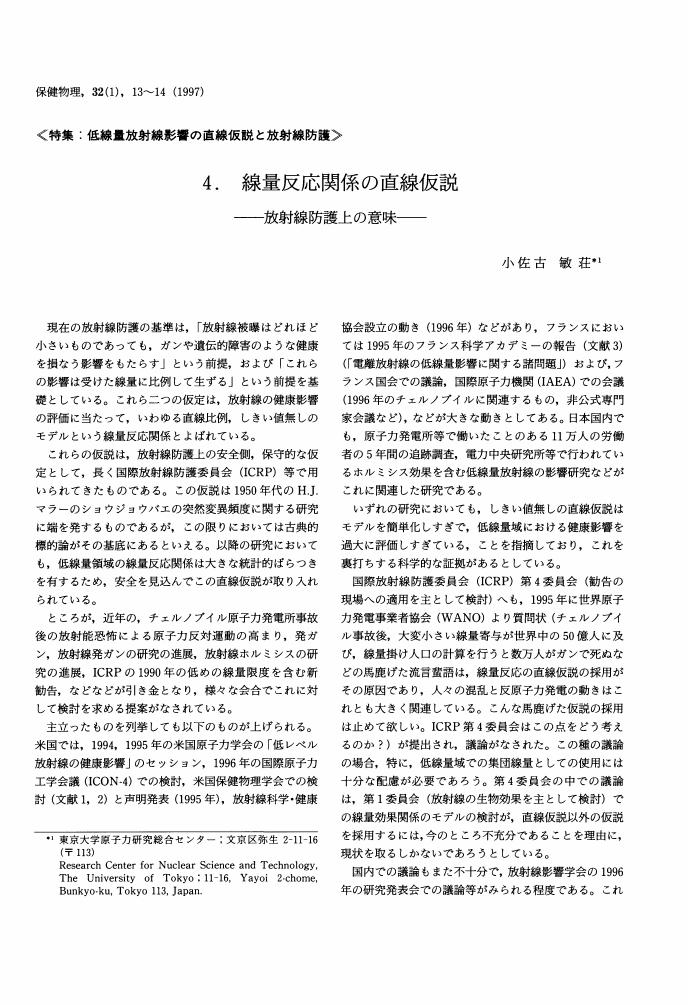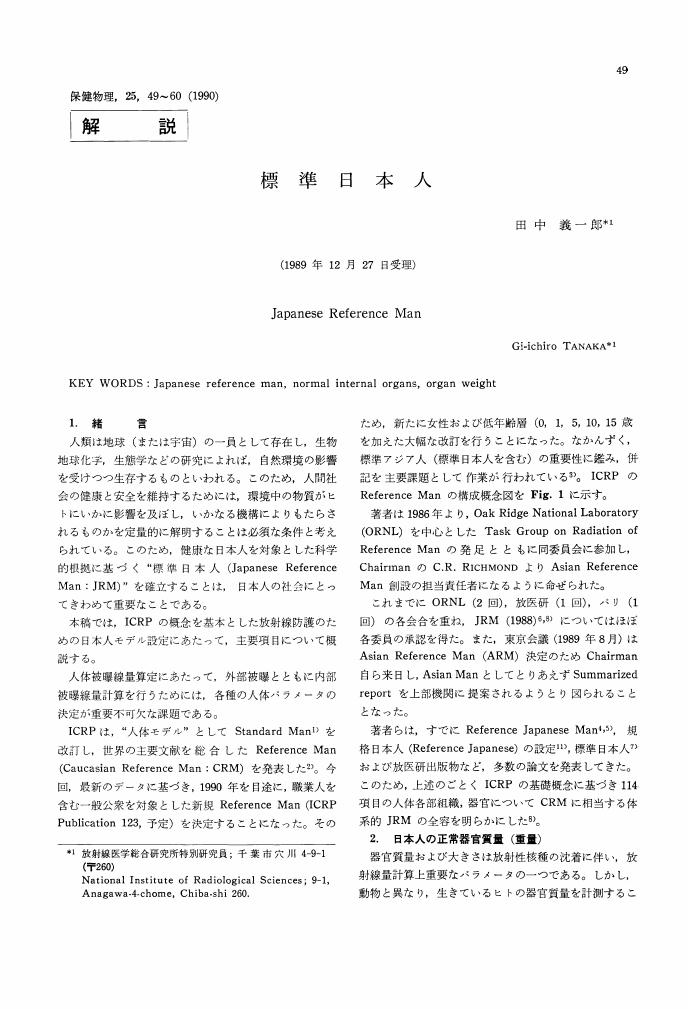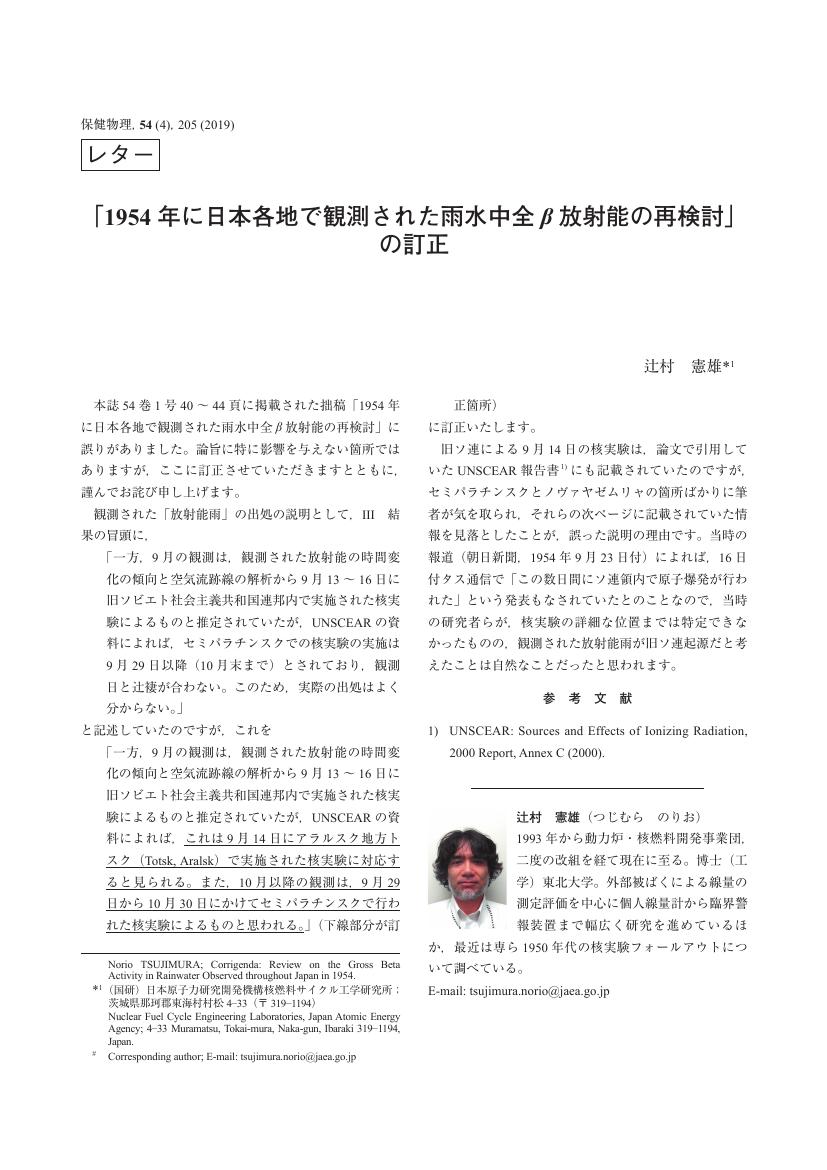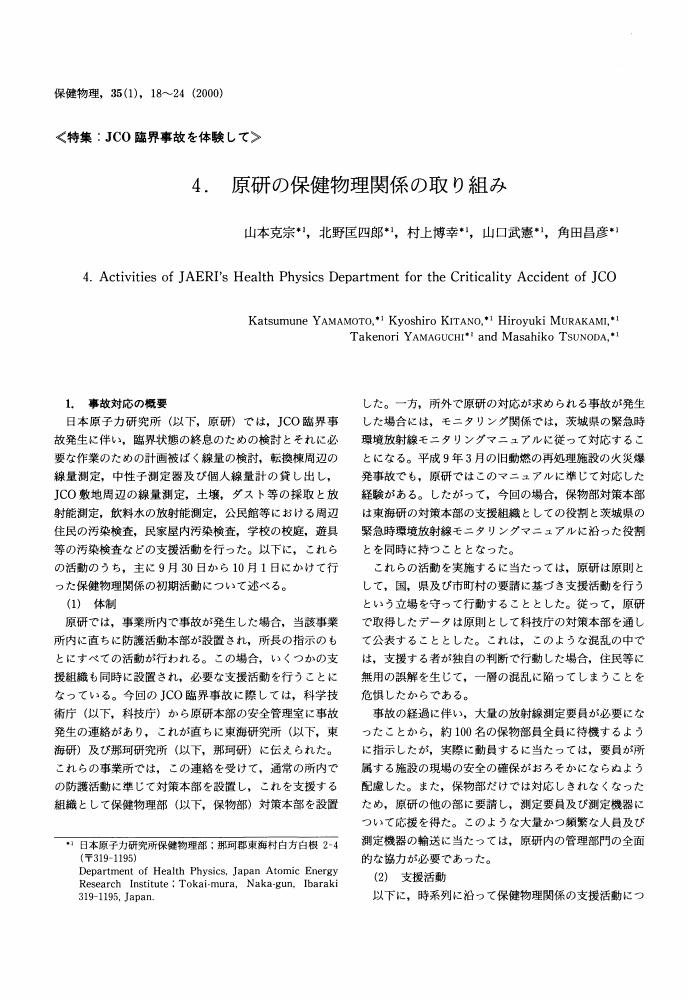2 0 0 0 OA ヒト以外の生物の放射線防護の枠組みの現状と課題
- 著者
- 川口 勇生
- 出版者
- 日本保健物理学会
- 雑誌
- 保健物理 (ISSN:03676110)
- 巻号頁・発行日
- vol.55, no.1, pp.23-31, 2020-04-01 (Released:2020-05-21)
- 参考文献数
- 43
An international framework for environmental radiation protection has been developed over the last few decades. From 2005 to 2017, the International Commission on Radiological Protection (ICRP) established a committee on environmental protection and published several reports. ICRP developed a protection framework which was based on the Reference Animals and Plants corresponding to the Reference Man in radiation protection of humans, and the Derived Consideration Reference Level which is the band of dose rates corresponding to the possibility of adverse effect of each animals and plants. The present review summarized the current state of the environmental protection system focusing on the activities of ICRP first and then of other international organizations. The current issues about environmental protection were also discussed.
2 0 0 0 OA 4. 線量反応関係の直線仮説 -放射線防護上の意味-
- 著者
- 小佐古 敏荘
- 出版者
- Japan Health Physics Society
- 雑誌
- 保健物理 (ISSN:03676110)
- 巻号頁・発行日
- vol.32, no.1, pp.13-14, 1997 (Released:2010-02-25)
- 参考文献数
- 5
2 0 0 0 OA 医療施設におけるさまざまなX線撮影室条件での散乱線分布可視化と表示ツール開発
- 著者
- 清水 翔太 荒川 弘之 本田 城二 徳森 謙二 藤淵 俊王
- 出版者
- 日本保健物理学会
- 雑誌
- 保健物理 (ISSN:03676110)
- 巻号頁・発行日
- vol.56, no.4, pp.315-323, 2021-12-28 (Released:2022-03-01)
- 参考文献数
- 24
- 被引用文献数
- 1
Clear radiation protection training and explanation tools for medical staff, patients, and caregivers during radiography are required. In this study, we developed visualization tool of scattered radiation distribution image of each X-ray room conditions. The 400 cases of X-ray room conditions were simulated using a Monte Carlo simulation code, Particle and Heavy Ion Transport code System (PHITS). The simulation conditions were (i) width and depth of the X-ray room (200 cm, 250 cm, 300 cm, 400 cm and 500 cm), (ii) opening or closing of the sliding door, (iii) direction of the X-ray table, (iv) X-ray posture, and (v) with or without protective clothing/shield. The scattered radiation distribution images were published on the Internet. The images are easily accessible on the Internet with selecting each radiography room condition. In radiation protection education, our tool can be used to (a) reduce radiation dose by keeping away from X-ray sources and scattered radiation sources, (b) shield scattered radiation by protective clothing and protective screens, and (c) prevent leakage of scattered radiation outside the room by closing the door of the radiography room. Our tool would improve the efficiency of radiation protection training for medical staff and alerting to patients and caregivers.
- 著者
- 佐藤 宏 高橋 千太郎 久保田 善久
- 出版者
- Japan Health Physics Society
- 雑誌
- 保健物理 (ISSN:03676110)
- 巻号頁・発行日
- vol.33, no.3, pp.298-301, 1998 (Released:2010-02-25)
- 参考文献数
- 18
- 被引用文献数
- 2
2 0 0 0 OA Intercomparisons Exercises of Radon and Thoron Monitors Provided by Four Laboratories: A Review
- 著者
- Miroslaw JANIK
- 出版者
- 日本保健物理学会
- 雑誌
- 保健物理 (ISSN:03676110)
- 巻号頁・発行日
- vol.52, no.2, pp.114-121, 2017 (Released:2017-07-29)
- 参考文献数
- 64
- 被引用文献数
- 5 10
Indoor radon and thoron concentration measurements have been intensively carried out since the 1980s for assessment of radiation doses to workers and the general public. For example, the European Union countries established reference levels for indoor radon concentration in relation to national action plans to address long-term risk from radon exposures. Measurements done using a reliable method are the only way to investigate radon concentration levels. In order to ensure the quality of measurements, intercomparisons among laboratories are performed, as one verification method. The primary purpose of this paper is to provide a concise review of intercomparisons of radon and thoron monitors carried out by four institutions: NIRS (Japan), PHE (UK), BfS (Germany) and SURO (Czech Republic). The different measurement set-ups, evaluation methods and statistical treatments utilized by those institutions are described.
2 0 0 0 OA 放射線事故時におけるセシウム除去としてのプルシアンブルー
- 著者
- 小林 信義 山本 泰 明石 真言
- 出版者
- Japan Health Physics Society
- 雑誌
- 保健物理 (ISSN:03676110)
- 巻号頁・発行日
- vol.33, no.3, pp.323-330, 1998 (Released:2010-02-25)
- 参考文献数
- 44
- 被引用文献数
- 7 8
Prussian blue, a blue pigment, belongs to the ferric cyanoferrate (II) group. It binds univalent metal ions, and the binding activity depends on their ionic radius. Prussian blue is not absorbed from the gastrointestinal tract in a significant amount. The cesium is entero-enteric cycled through the intestine. Prussian blue inhibits the reabsorption of the cesium. Many studies using experimental animals showed that the oral administration of Prussian blue increases the rate of the fecal excretion of radiocesium which results in shortening its biological half life. The accident in Goiania, Brazil, in 1987 showed that Prussian blue effectively accelerated the removal of radiocesium without toxicity. In the present review, we describe Prussian blue from a biological aspect and discuss its clinical application for the decontamination of cesium in radiation accidents.
2 0 0 0 OA 放射線白内障に対するしきい線量の科学的根拠と課題
- 著者
- 藤通 有希 小佐古 敏荘 吉田 和生 浜田 信行
- 出版者
- 日本保健物理学会
- 雑誌
- 保健物理 (ISSN:03676110)
- 巻号頁・発行日
- vol.48, no.2, pp.97-103, 2013 (Released:2014-03-06)
- 参考文献数
- 25
- 被引用文献数
- 2 1 1
Radiation cataract has been classified as tissue reactions (formerly known as deterministic effects or non-stochastic effects) with a threshold dose. In 1984, the International Commission on Radiological Protection (ICRP) suggested the threshold dose of >8 Sv for vision-impairing cataracts in highly fractionated or protracted exposures. Such a threshold was used to recommend an occupational dose limit for the lens of 150 mSv/year in 1990 and 2007, but was reduced to 0.5 Sv in 2011 for all exposure scenarios irrespective of the rate of dose delivery. New threshold was determined on the basis of the limited human evidence, with various hypotheses not supported by the present knowledge of biological mechanisms. Examples of untested hypotheses include: (a) radiation cataract is a tissue reaction; (b) radiation damage to the large number of cells acts as a triggering event for radiation cataract; (c) detectable minor opacities progress into vision-impairing cataracts with time; and (d) the lower the dose, the longer the latency. This paper discusses the issues behind the scientific basis for the new threshold, and provides directions for future epidemiological and biological studies to establish the reasonably modeled dose-response relationship for radiation cataract.
- 著者
- 栗原 千絵子
- 出版者
- 日本保健物理学会
- 雑誌
- 保健物理 (ISSN:03676110)
- 巻号頁・発行日
- vol.54, no.1, pp.19-28, 2019-04-18 (Released:2019-09-03)
- 参考文献数
- 26
- 被引用文献数
- 2
The International Commission on Radiological Protection (ICRP) issued in February 2018 the Publication 138, titled “Ethical foundation of radiological protection system.” Although the ICRP has longtime recognized that ethics is an essential component of their radiological protection system, they have rarely described explicitly about the ethical foundation of the system. For this reason, the Commission established in 2012 the task group 94 to clarify and describe the ethical foundation of the system. As the result, the publication shows the process of evolution of the radiological protection system through 20th century until now, which leads to the identification of four core ethical values underpinning the system: beneficence and non-maleficence; prudence; justice; and dignity, along with related procedural values: accountability; transparency; and inclusiveness (stakeholder participation). As one of the authors of this publication, I will briefly introduce the developing process and the outlines of it, and additionally will provide a short summary of my experience of discussion through the workshops worldwide, concerning the nuclear accident of the Fukushima Daiichi Nuclear Power Station, as well as commonalities and diversities of Western and Asian perspectives of ethical core values.
2 0 0 0 OA 生体中の微量元素の役割
- 著者
- 山根 靖弘
- 出版者
- Japan Health Physics Society
- 雑誌
- 保健物理 (ISSN:03676110)
- 巻号頁・発行日
- vol.25, no.3, pp.269-277, 1990 (Released:2010-02-25)
- 参考文献数
- 4
- 被引用文献数
- 1
2 0 0 0 OA JEUNESSE-2: 年齢群別外部被曝実効線量計算コード
- 著者
- 山口 恭弘
- 出版者
- Japan Health Physics Society
- 雑誌
- 保健物理 (ISSN:03676110)
- 巻号頁・発行日
- vol.29, no.3, pp.303-308, 1994 (Released:2010-02-25)
- 参考文献数
- 17
A new version of the dose calculation program, JEUNESSE-2 code, was developed which copes with external neutrons as well as photons. The code is capable of calculating the effective dose E for six different age groups: 0-, 1-, 5-, 10- and 15-year, and adult. The continuous function of the radiation weighting factor and the new tissue weighting factors, specified in ICRP Publication 60, were employed in the calculation of E. The Monte Carlo code MORSE-CG was incorporated in the JEUNESSE-2 code to calculate the transport of neutrons and produced γ-rays from a source to organs or tissues of the phantoms. A sample calculation for isotropic neutron incidence showed a significant age dependence of E. A comparison of the resultant E for adult males with other results gave good agreement.
2 0 0 0 OA 診断X線検査による乳幼児, 小児, 成人の被ばく線量
- 著者
- 青山 隆彦 小山 修司 川浦 稚代 杉本 成人 藤井 啓輔 瀬口 繁信 川崎 稔生
- 出版者
- 日本保健物理学会
- 雑誌
- 保健物理 (ISSN:03676110)
- 巻号頁・発行日
- vol.47, no.4, pp.270-281, 2012 (Released:2013-12-17)
- 参考文献数
- 17
- 被引用文献数
- 1
Data are presented on radiation doses to infant, child and adult patients undergoing head, chest and abdominal CT examinations with recent multi-detector row CT scanners (MDCT). Also presented are dose data in CT coronary angiography(CTCA) observed with Toshiba 320MDCT and Siemens 64MDCT. The doses were measured using newborn, 6-year-child and adult anthropomorphic phantoms, in which photodiode dosimeters were implanted at various tissue and organ positions. Measured doses were used to evaluate organ and effective doses. Organ doses in the scan region obtained in head CT were 20-40 mGy for infants and children, and 40-70 mGy for adults. Effective doses in head CT were 2.1-3.3 mSv for infants,and 1.0-2.0 mSv for children and adults. These doses in chest CT were 3-9 mGy and 2-6 mSv for infants, 2-12 mGy and 1-7 mSv for children, and 5-35 mGy and 7-14 mSv for adults. In abdominal CT they were 3-14 mGy and 2-10 mSv for infants, 4-18 mGy and 3-12 mSv for children, and 10-48 mGy and 9-21 mSv for adults. In CTCA radiation doses for helicalscan without using dose modulation were reduced to less than 1/6 and 1/10 by using prospectively gated axial scan of Toshiba320MDCT and “Flash Spiral” scan of Siemens 64MDCT, respectively.
2 0 0 0 OA 標準日本人
- 著者
- 田中 義一郎
- 出版者
- Japan Health Physics Society
- 雑誌
- 保健物理 (ISSN:03676110)
- 巻号頁・発行日
- vol.25, no.1, pp.49-60, 1990 (Released:2010-02-25)
- 参考文献数
- 25
- 被引用文献数
- 3 2
2 0 0 0 OA 放射線のリスクコミュニケーションに係る基本的事項
- 著者
- 篠原 邦彦 大内 浩子 近本 一彦 谷口 和史 永井 博行 森本 恵理子 米澤 理加 渡辺 浩
- 出版者
- 日本保健物理学会
- 雑誌
- 保健物理 (ISSN:03676110)
- 巻号頁・発行日
- vol.44, no.4, pp.374-379, 2009 (Released:2011-01-12)
- 参考文献数
- 19
- 被引用文献数
- 1 2
In the field of atomic energy and radiation utilization, radiation risk is considered as one of the social uneasy factors. About the perception of risks, there is a gap between experts and general public (non-experts). It is said that the general public tends to be going to judge risk from intuitive fear and a visible concrete instance whereas the experts judge it scientifically. A company, an administration or experts should disclose relating information about the risks and communicate interactively with the stakeholders to find the way to solve the problem with thinking together. This process is called “risk communication”. The role of the expert is important on enforcement of risk communication. They should be required to explain the information on the risks with plain words to help stakeholders understand the risks properly. The Japan Health Physics Society (JHPS) is the largest academic society for radiation protection professionals in Japan, and one of its missions is supposed to convey accurate and trustworthy information about the radiation risk to the general public. The expert group on risk communication of ionizing radiation of the JHPS has worked for the purpose of summarizing the fundamental matters on radiation risk communication. “Lecture on risk communication for the members of the JHPS.” which has been up on the JHPS web-site, and the symposium of “For better understanding of radiation risk.” are a part of the activities. The expert group proposes that the JHPS should enlighten the members continuously for being interested in and practicing risk communication of radiation.
2 0 0 0 OA 「1954 年に日本各地で観測された雨水中全β放射能の再検討」 の訂正
- 著者
- 辻村 憲雄
- 出版者
- 日本保健物理学会
- 雑誌
- 保健物理 (ISSN:03676110)
- 巻号頁・発行日
- vol.54, no.4, pp.205, 2019-12-27 (Released:2020-01-31)
- 参考文献数
- 1
2 0 0 0 OA ICRU Report 56“放射線防護のための外部ベータ線のドジメトリー”の解説
- 著者
- 飯田 孝夫
- 出版者
- Japan Health Physics Society
- 雑誌
- 保健物理 (ISSN:03676110)
- 巻号頁・発行日
- vol.33, no.3, pp.345-354, 1998 (Released:2010-02-25)
- 著者
- Mikhail BALONOV
- 出版者
- Japan Health Physics Society
- 雑誌
- 保健物理 (ISSN:03676110)
- 巻号頁・発行日
- vol.54, no.3, pp.161-171, 2019-10-29 (Released:2019-11-21)
- 参考文献数
- 32
- 被引用文献数
- 1
In the history of the world nuclear industry there were four major accidents of operating nuclear reactors, i.e., at plutonium production facility in Windscale, UK, 1957; at NPP Three Mile Island, USA, 1979; at Chernobyl NPP, USSR, 1986; and at Fukushima-1 NPP, Japan, in 2011. The Chernobyl accident was the most severe, causing a huge release and deposition of radionuclides over large areas of Europe. Only after this accident there were real health effects caused by radiation, including carcinogenic effect among the population of the adjacent areas of Belarus, Russia and Ukraine. In this paper, same-type basic radiological characteristics are presented for four reactor accidents with more detail presented for the Chernobyl accident. The latter include mean radiation doses incurred by various groups of inhabitants of the three more affected countries, Belarus, Russia and Ukraine. Those who were children at the time and drank milk with high levels of radioactive iodine received high thyroid doses. Since early 1990s there was dramatic increase in thyroid cancer incidence among those exposed to radioiodine at a young age. Apart from this kind of health effects there was no clearly demonstrated increase in the somatic diseases due to radiation. The paper discusses the reasons why the Chernobyl accident had severe radiological consequences.
- 著者
- Jean-François LECOMTE Amber BANNON Yann BILLARAND Peter BRYANT Marie-Claire CANTONE Roger COATES John CROFT Stéphane JEAN-FRANÇOIS Bernard Le GUEN Caroline SCHIEBER Thierry SCHNEIDER
- 出版者
- 日本保健物理学会
- 雑誌
- 保健物理 (ISSN:03676110)
- 巻号頁・発行日
- vol.54, no.3, pp.188-194, 2019-10-29 (Released:2019-11-21)
- 参考文献数
- 8
2 0 0 0 OA 医療被ばくに関する線量評価法
- 著者
- 松原 孝祐 Thunyarat CHUSIN 大久保 玲奈 小川 善紀
- 出版者
- 日本保健物理学会
- 雑誌
- 保健物理 (ISSN:03676110)
- 巻号頁・発行日
- vol.53, no.4, pp.238-246, 2018 (Released:2019-03-03)
- 参考文献数
- 39
Evaluation of radiation dose from medical exposure is important because the use of ionizing radiation in medical field contributes significantly to the exposure of the population. In plain radiography, the entrance skin dose, which is absorbed by the skin as it reaches the patient, is generally estimated. It is calculated from the air kerma at the same focus skin distance on the beam central axis measured with a dosimeter. In fluoroscopy, the indirect monitoring using dose-area product meter is generally performed for estimating the entrance skin dose in real-time to avoid skin injuries. In mammography, the average glandular dose is estimated because mammary glands have more sensitive to radiation than skin. The European Organization for Quality-Assured Breast Screening and Diagnostic Services protocol has been used to estimate average glandular dose from full-field digital mammography in Japan. Although volume CT dose index or dose-length product, as seen on CT consoles, do not represent the actual dose for the patient, they are measured to assist in quality control and optimization as well as the air kerma rate at the patient entrance reference point in fluoroscopy and the average glandular dose in mammography. For the purpose of patient dose evaluation, physical dose measurements using an anthropomorphic phantom and Monte Carlo simulations can estimate patient organ doses from medical exposure.
2 0 0 0 OA ICRP Publication 74の概要と新しい外部被ばく線量換算係数
- 著者
- 山口 恭弘
- 出版者
- 日本保健物理学会
- 雑誌
- 保健物理 (ISSN:03676110)
- 巻号頁・発行日
- vol.33, no.1, pp.12-15, 1998 (Released:2010-02-25)
- 参考文献数
- 10
2 0 0 0 OA 原研の保健物理関係の取り組み
- 著者
- 山本 克宗 北野 匡四郎 村上 博幸 山口 武憲 角田 昌彦
- 出版者
- Japan Health Physics Society
- 雑誌
- 保健物理 (ISSN:03676110)
- 巻号頁・発行日
- vol.35, no.1, pp.18-24, 2000 (Released:2010-02-25)








